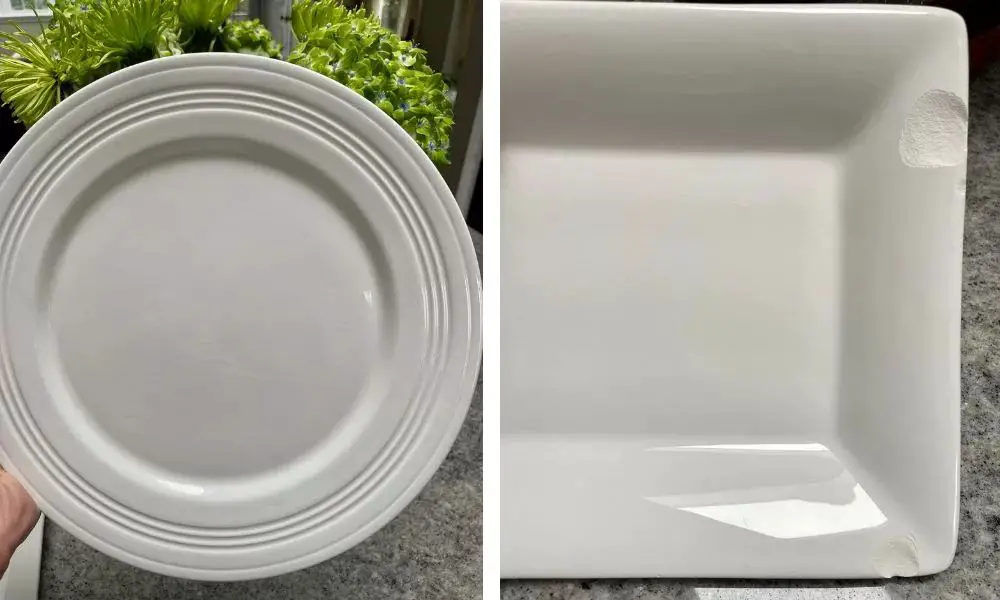How Do You Identify Bone China?
Bone china is a type of porcelain that is composed of bone ash, feldspathic material, and kaolin. It was first developed in England in the late 18th century by Josiah Spode. Thomas Frye is credited with pioneering the use of bone ash in porcelain mixtures in 1748 at the Bow Porcelain Factory in East London. Bone ash, made by calcining animal bone, provides additional translucency and whiteness to the porcelain body while improving workability and durability.
According to Wedgewood’s guide, the introduction of bone ash by Spode revolutionized porcelain production and helped establish English bone china as a leading luxury product by the early 19th century.
Bone china is known for its high quality, beauty, and prestige. It is considered the finest and most translucent type of porcelain due to its high firing temperatures and the addition of bone ash.
Composition
Bone china contains three key ingredients: bone ash, kaolin, and feldspar. According to The Royalware Company, the composition of bone china is approximately 25-45% bone ash, 25-50% kaolin, and 25-45% feldspar. The bone ash, which comes from cattle bones, gives bone china its trademark translucency and whiteness. The kaolin, also known as china clay, provides plasticity and strength. Feldspar acts as a flux to lower the vitrifying temperature. This delicate combination of minerals enables bone china to be fired at a high temperature to become non-porous and highly durable while retaining a fine, smooth texture.
Translucency
One of the distinguishing characteristics of bone china is its thin, translucent quality. When held up to the light, bone china will appear semi-transparent, allowing light to shine through the piece. This translucency is achieved through the high firing temperatures and addition of bone ash during production, resulting in a very fine, lightweight material. According to Royal Doulton in a 1961 print ad, “Bone China Translucency” is a key indicator of quality bone china pieces. The thinner and more translucent the china, the higher quality it is considered. This allows bone china to take on a refined, delicate aesthetic unlike other ceramics and porcelain which cannot achieve the same level of thinness and translucency (Royal Doulton). When examining bone china, one should look for a high degree of light passing through the material to identify it.
Weight
One of the distinguishing features of bone china is its light weight compared to other ceramics. While porcelain typically weighs up to 1.7 grams per cubic centimeter, bone china weighs only around 1.3 grams per cubic centimeter.
This light weight is a result of the unique composition of bone china, which contains at least 25% bone ash in addition to porcelain clay. The bone ash makes the material more porous and translucent, and also reduces the overall weight. According to the Nitori product listing, a bone china spoon weighs only 0.02kg. A Mikasa bone china dinner plate is described as weighing 2 lbs.
The light weight of bone china is one of the quickest ways to identify it and distinguish it from heavier porcelain items. Just by picking up a dish or cup, the lower heft immediately indicates it is likely made from delicate bone china rather than sturdy porcelain.
Color

One of the distinguishing characteristics of bone china is its bright white color with a slight blue or grey tint. This is due to the phosphate content in the bone ash used in its production, which results in bone china having a cooler, bluish undertone compared to other porcelain (CrispEdge.com). The translucency of bone china also accentuates the blue-white color. While not stark white, the pale, cool tone is recognizable and gives bone china its signature look. When comparing pieces side-by-side, bone china will appear brighter and less warm than porcelain.
Pattern
One of the hallmarks of bone china is the intricate, hand-painted patterns featured on many pieces. According to The Minton Archive, bone china manufacturers like Minton have been hand-painting beautiful designs on their wares since the early 19th century. The earliest Pattern Book from Minton shows the careful, artistic sensibility that bone china is known for. Each piece of bone china has its own unique painted pattern that required great skill and attention to detail by the artisans painting them.
Vintage and antique bone china tends to feature more elaborate, ornate patterns. Modern bone china still utilizes hand-painted patterns but they may be more minimalist or geometric. Either way, the patterns on bone china are an indicator of the quality and craftsmanship as each pattern is applied by a skilled artist. When examining bone china, look closely at the brush strokes and painterly details that make each piece special.
Craftsmanship
Bone china requires a high degree of skilled craftsmanship to produce. The process involves several meticulous steps and techniques that artisans have perfected over centuries.
Mold making itself is an intricate process that requires experienced craftsmen to produce the detailed and complex shapes and patterns found on bone china pieces. According to Luxury Bone China, “Depending on the intricacy of the design, it can take weeks for a master mold maker to develop a single mold.”
The mold making must also account for the high shrinkage rate of bone china when fired, requiring precision calculations. The Luxury Bone China article notes that bone china shrinks 12-14% during firing. The craftsman must compensate for this shrinkage when making the molds.
Finally, the decorated bone china pieces require expert decorative techniques like hand-painting, gilding, transferring decals, and glazing. According to How Stuff Works, “Decorating is truly an art form requiring patience and a steady hand.” The finest bone china demands this level of talented artistry.
Sound
When tapped, the ring sound of fine bone china plates is a distinctive indicator of their composition and quality. Bone china has a high timbre and resonant ring compared to other porcelain dinnerware due to its thinness and higher density [1]. The clear, melodic tone when gently struck comes from the higher calcium phosphate content, creating a more vitreous and elastic body [2]. Lower quality bone china with lower bone ash percentages produces a more deadened, dull sound. The higher fired bone china has a more glass-like structure, resulting in the purer chime. Experienced bone china collectors often tap pieces to listen for this bright, long-lasting reverberation as an authentication method.
[1] https://soundcloud.com/santolina/sets/bonechinasoundevanif_sounds-from-bone-china-land
[2] https://www.hindlish.com/sound/bone%20china-sound-pronunciation
Manufacturer Marks
Bone china will usually have a manufacturer’s mark printed on the bottom or backstamped. This mark is key to identifying the maker and approximate date. According to Antique Marks, ceramics marked “English Bone China” or just “Bone China” were made in Britain. Well-known British bone china manufacturers include Royal Worcester, Wedgwood, Spode, Royal Albert, and Royal Crown Derby.
The mark often includes the manufacturer’s name, sometimes along with a logo, pattern name, and date codes. For example, a piece marked “ROYAL ALBERT, BONE CHINA, ENGLAND” can be identified as made by the Royal Albert company in England. The mark style can provide a clue to the date – earlier manufacturer marks were often handwritten while later marks became standardized. Resources like the Buttercup China website have guides to identifying marks by manufacturer and year.
Testing
There are a few ways to test whether a piece is actually made from bone china or just porcelain pretending to be bone china:
- Check the manufacturer’s mark – Authentic bone china will be marked as such by reputable manufacturers.
- Do a translucency test – Hold the piece up to a bright light. Bone china will let more light shine through because of its higher translucency.
- Listen to the sound – Gently tap the piece. Bone china has a clearer, more resonant ring than porcelain.
- Verify with XRF testing – Use X-ray fluorescence (XRF) testing to analyze the elemental composition. Bone china contains over 25% bone ash.
- Weigh the piece – Bone china feels lighter than porcelain due to lower feldspar content. Weigh a similar sized porcelain piece for comparison.
For definitive proof, XRF testing is recommended. Look for certified lab results showing 25-45% bone ash content for real bone china. Beware of fakes trying to pass off as luxury bone china!
Sources:

